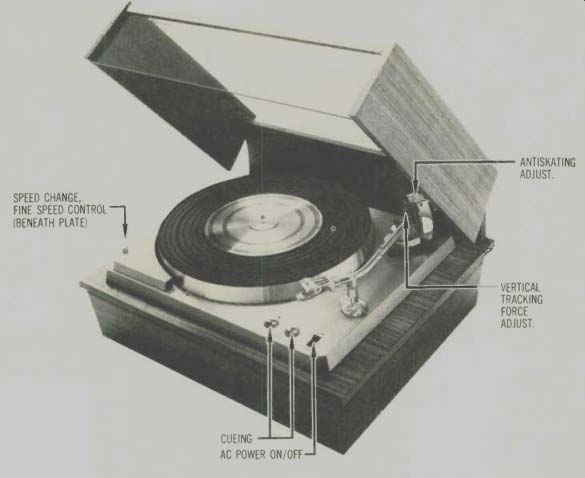
The Equipment: Empire 698, a manual single -play turn table, with base and dust cover.
Dimensions: 17 1/2 by 15 inches (top); 8 3/8 inches high, 22 1/4 inches clearance required with cover fully open.
Price: $400.
Warranty: "limited," one year parts and labor.
Manufacturer: Empire Scientific Corp., 1055 Stewart Ave., Garden City, N.Y. 11530.
Comment: The Empire 698 manual turntable candidly displays its filial relation to the earlier 598, retaining essentially the same cosmetics and drive system. The principal difference between the two models is that the 698 includes a newly designed, lightweight tone arm equipped with electronic cueing and a photocell-controlled automatic lift at the end of a record. The arm also has such niceties as a headshell designed for minimum mass, antiskating bias that varies (as, ideally, it should) as the arm moves across the disc, and a decoupled counterweight that minimizes resonant effects and improves tracking of warped records.
Empire's belt-drive system, which was signally ahead of its time when introduced in the 598, performs very well by to day's standards too. CBS Technology Center measured peak flutter (ANSI/ IEEE weighting) at 0.08% maximum and 0.04% average, figures that fall in the good -to -excel lent range. Rumble, which measures -61 dB with ARLL weighting, is likewise very good. (Empire, using ARLL weighting but a less stringent measurement technique, specifies -68 dB--a figure the lab was able to duplicate substantially when it copied the manufacturer's technique.) Speed (33 or 45 rpm) remains exact at all test power-line voltages.
The retention of the familiar Empire drive scheme implies some restrictions in convenience. Fine speed control is quite limited in range (significantly less than a semitone at either speed) and is accomplished by means of a vernier screw that changes the axis of the motor and drive pulley.
To switch the speed it is necessary to remove a metal cover (which also conceals the fine speed adjustment) and guide the belt by hand from one drive-pulley step to the other, taking care to have the belt move into proper alignment around the platter and not pop back to the wrong part of the pulley. This system is easier to use than to describe and does have the virtue of simplicity, but it may seem, to some users, somewhat incongruous with electronic arm cueing.
Taking resonant frequency as a general measure of tonearm mass, we find the Empire's entirely competitive with other late -model arms. With the extremely compliant Shure V-15 Type III pickup it resonates at 7.5 Hz but shows very good damping in holding the rise to just 2 dB. Pivot friction in the arm mount is negligible for both vertical and horizontal movement, and there is no perceptible side drift in cueing. The cueing lifter does not support the arm once it is well clear of the platter, so you must be careful to lift and not push the arm when returning it to its rest.
Vertical tracking force is applied by means of a spring (calibrated in half-gram increments) so that the accuracy of this force is not dependent on having the turntable perfectly level. In the range from 1 to 4 grams the measured tracking force is 0.2 gram lighter than indicated at all set tings. Antiskating bias, on the other hand, is exactly as set (again in half-grams of VTF) throughout the range; a table is provided in the instruction sheet to show how the bias should be adjusted for various stylus shapes.
In its construction the Empire is robust, not to say massive. The dust cover is of the friction-hinged rather than liftoff variety, but its mass is sufficient and the suspension of the working parts compliant enough that we would expect no problem with acoustic feedback--and, in fact, found none. Setting up the unit is not the simplest of tasks, but the instructions make it comparatively easy.
In auditioning the 698, we found its sonic performance just fine. Tracking is good, even on warped records, and there is no trace of audible misbehavior. We would conclude that Empire has done a clever job of refining an existing "classic" design.
-------------
(High Fidelity, Apr. 1977)
Also see:
Empire 698 turntable (ad, Apr. 1977)
Hitachi SR-903 receiver (Equip Profile, Apr. 1977)
ADC--Accutrac turntable (ad, Apr. 1977)